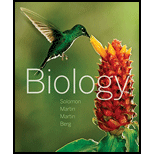
Concept explainers
Test Your Understanding
Know and Comprehend
1. Seed plants lack which of the following structure(s)? (a) ovules surrounded by integuments (b) microspores and megaspores (c) vascular tissues (d) a large, nutritionally independent sporophyte (e) a large, nutritionally independent gametophyte
Introduction: Seed is a part of plant, which contains an embryo that will give rise to a new plant, stores food material in the form of “endosperm” for the growth of embryo, and seed coat for the protection of seed.
Answer to Problem 1TYU
Correct answer: Seed plants does not possess a “large, nutritionally independent gametophytic” structure. Hence, the correct answer is option (e).
Explanation of Solution
Reason for the correct answer:
Seeds are present inside the ovary, which is known as female gametophyte. The function of female gametophyte is to provide nutrition to a number of ovules that requires a large amount of nutrition. Gametophytes are microscopic in size and have endosperm in it as a reserve food material for the development of plant when the seed is set for the process of germination. Thus, if a nutritionally independent gametophyte is present then the development of the ovules will not be possible, which will result in the deterioration of ovules.
Option (e) is given as “a large, nutritionally independent gametophyte”.
A seed plant does not have a nutritionally independent gametophyte because the gametophyte depends upon the sporophyte for the nutrition. Hence, the correct answer is option (e).
Reasons for the incorrect answers:
Option (a) is given as “ovules surrounded by integuments”.
Seed plants produce ovules which are surrounded by the integuments. Later on, those integuments will result in the formation of seed coat and serve as a protective covering of the seed. Hence, option (a) is incorrect.
Option (b) is given as “microspores and megaspores”.
Seed plants produce both kinds of spores such as microspores (male gamete) and megaspores (female gamete). The condition of producing both types of spores is known as heterospory. Hence, option (b) is incorrect.
Option (c) is given as “vascular tissues”.
Plant body uses vascular tissues for the transport of food materials and water for the proper growth of plant body. Thus, vascular tissues are present in seed plants. Hence, option (c) is incorrect.
Option (d) is given as “a large, nutritionally independent sporophyte”.
Most of the seed plants have a large, nutritionally independent sporophyte. Hence, option (d) is incorrect.
Hence, options (a), (b), (c), and (d) are incorrect.
Nutritionally independent gametophyte is not present in seed plants.
Want to see more full solutions like this?
Chapter 28 Solutions
Biology (MindTap Course List)
- Can you described the image? Can you explain the question as well their answer and how to get to an answer to an problem like this?arrow_forwardglg 112 mid unit assignment Identifying melting processesarrow_forwardGive only the mode of inheritance consistent with all three pedigrees and only two reasons that support this, nothing more, (it shouldn't take too long)arrow_forward
- Oarrow_forwardDescribe the principle of homeostasis.arrow_forwardExplain how the hormones of the glands listed below travel around the body to target organs and tissues : Pituitary gland Hypothalamus Thyroid Parathyroid Adrenal Pineal Pancreas(islets of langerhans) Gonads (testes and ovaries) Placentaarrow_forward
- What are the functions of the hormones produced in the glands listed below: Pituitary gland Hypothalamus Thyroid Parathyroid Adrenal Pineal Pancreas(islets of langerhans) Gonads (testes and ovaries) Placentaarrow_forwardDescribe the hormones produced in the glands listed below: Pituitary gland Hypothalamus Thyroid Parathyroid Adrenal Pineal Pancreas(islets of langerhans) Gonads (testes and ovaries) Placentaarrow_forwardPlease help me calculate drug dosage from the following information: Patient weight: 35 pounds, so 15.9 kilograms (got this by dividing 35 pounds by 2.2 kilograms) Drug dose: 0.05mg/kg Drug concentration: 2mg/mLarrow_forward
- A 25-year-old woman presents to the emergency department with a 2-day history of fever, chills, severe headache, and confusion. She recently returned from a trip to sub-Saharan Africa, where she did not take malaria prophylaxis. On examination, she is febrile (39.8°C/103.6°F) and hypotensive. Laboratory studies reveal hemoglobin of 8.0 g/dL, platelet count of 50,000/μL, and evidence of hemoglobinuria. A peripheral blood smear shows ring forms and banana-shaped gametocytes. Which of the following Plasmodium species is most likely responsible for her severe symptoms? A. Plasmodium vivax B. Plasmodium ovale C. Plasmodium malariae D. Plasmodium falciparumarrow_forwardStandard Concentration (caffeine) mg/L Absorbance Reading 10 0.322 20 0.697 40 1.535 60 2.520 80 3.100arrow_forwardPlease draw in the missing answer, thank youarrow_forward
 Biology (MindTap Course List)BiologyISBN:9781337392938Author:Eldra Solomon, Charles Martin, Diana W. Martin, Linda R. BergPublisher:Cengage Learning
Biology (MindTap Course List)BiologyISBN:9781337392938Author:Eldra Solomon, Charles Martin, Diana W. Martin, Linda R. BergPublisher:Cengage Learning Biology: The Dynamic Science (MindTap Course List)BiologyISBN:9781305389892Author:Peter J. Russell, Paul E. Hertz, Beverly McMillanPublisher:Cengage Learning
Biology: The Dynamic Science (MindTap Course List)BiologyISBN:9781305389892Author:Peter J. Russell, Paul E. Hertz, Beverly McMillanPublisher:Cengage Learning Biology: The Unity and Diversity of Life (MindTap...BiologyISBN:9781305073951Author:Cecie Starr, Ralph Taggart, Christine Evers, Lisa StarrPublisher:Cengage Learning
Biology: The Unity and Diversity of Life (MindTap...BiologyISBN:9781305073951Author:Cecie Starr, Ralph Taggart, Christine Evers, Lisa StarrPublisher:Cengage Learning Biology Today and Tomorrow without Physiology (Mi...BiologyISBN:9781305117396Author:Cecie Starr, Christine Evers, Lisa StarrPublisher:Cengage Learning
Biology Today and Tomorrow without Physiology (Mi...BiologyISBN:9781305117396Author:Cecie Starr, Christine Evers, Lisa StarrPublisher:Cengage Learning Biology 2eBiologyISBN:9781947172517Author:Matthew Douglas, Jung Choi, Mary Ann ClarkPublisher:OpenStax
Biology 2eBiologyISBN:9781947172517Author:Matthew Douglas, Jung Choi, Mary Ann ClarkPublisher:OpenStax Biology: The Unity and Diversity of Life (MindTap...BiologyISBN:9781337408332Author:Cecie Starr, Ralph Taggart, Christine Evers, Lisa StarrPublisher:Cengage Learning
Biology: The Unity and Diversity of Life (MindTap...BiologyISBN:9781337408332Author:Cecie Starr, Ralph Taggart, Christine Evers, Lisa StarrPublisher:Cengage Learning





